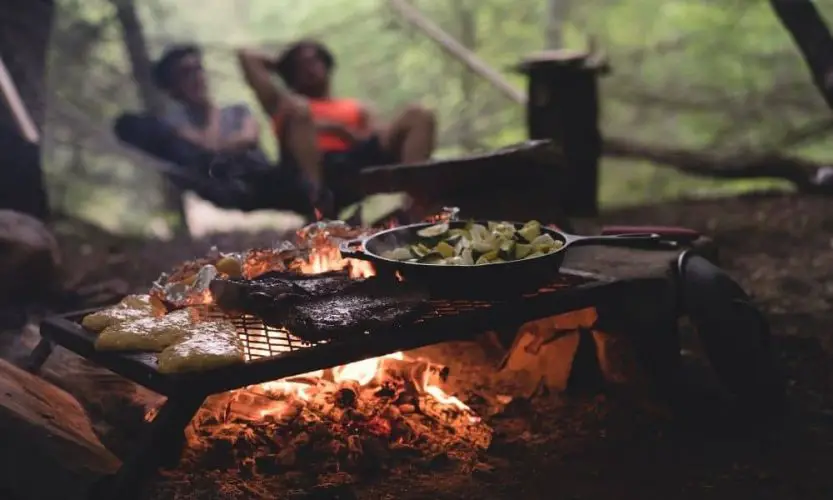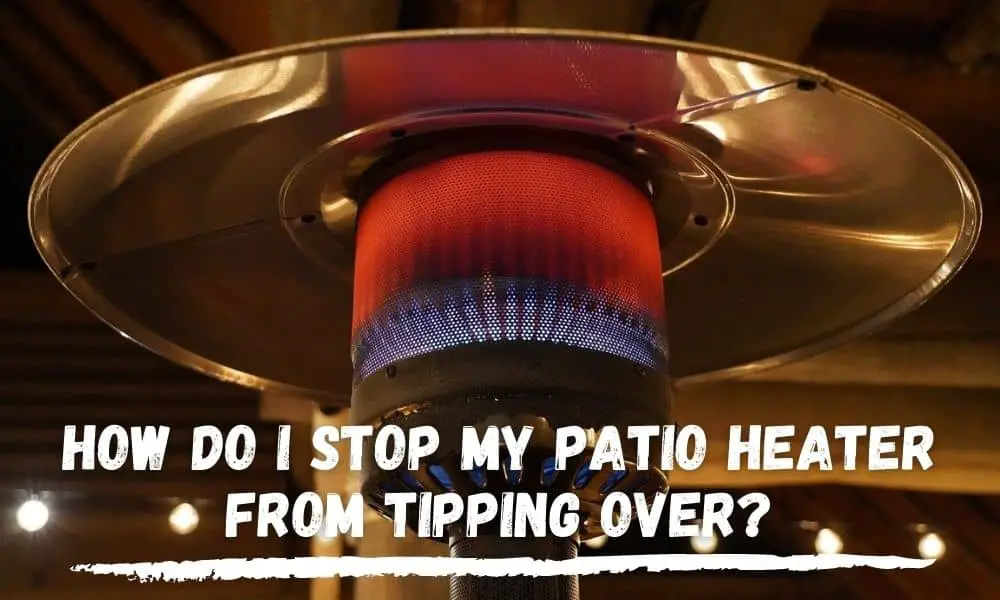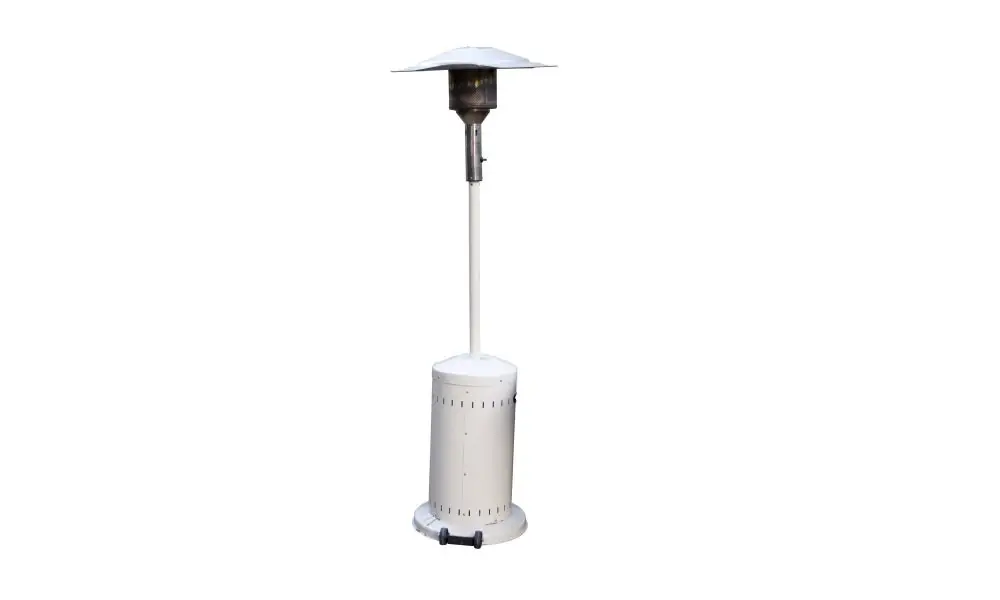Finally! All the block laying, pit digging, gas installations, and so forth are over. It’s now time to relax and enjoy the warmth from your fire pit. However, it’s not all about sitting in the backyard, stretching your roasting sticks, and getting your marshmallows ready.

Did you know there are trees you should never use when cooking in your backyard fire pit? We will guide you on fire pit cooking and all the dos and don’ts involved. Plus, we have a few mouth-watering recipes you can try on your open fire pit this evening!
Quick Navigation
Rules to Follow During Fire Pit Cooking
Here is what you need to know when you want to cook over an open fire pit:
Fuel Choices Dictate Your Meals Quality
When using a wood fire pit for cooking, you need firewood that is easy to light, burns hot, and lasts long.
Most of the time, we overlook all these specifications and opt for the cheapest or readily available option. The type of wood you are using and how well-seasoned it is will determine its efficiency.
Let us look at the top types of firewood to use in your wood fire pit when cooking:
Ash
This is one of the best well-seasoned woods that lights quickly and burns very hot in fire pits. Using it for fire pit cooking is a breeze, especially the white ash type. You can use ash to make smoked red meats and fish.
Beech
Using beech for fire pit cooking is a great way to make delicious food. It burns as hot as ash and lasts equally long. However, it takes a little longer to dry because it has a higher moisture content. Furthermore, it is a little difficult to split, and it’s lighter as compared to ash.
Hickory
It is a hardwood that burns extremely hot in fire pits. It dries within a short while, and its fire burns for a long time. When burning, it produces a pleasant aroma. Common types of hickory are bitternut and shagbark. It has a strong bacon flavor. It can make quality, smoked ham, pork, and beef.
Maple
Is one of the most readily available woods. Its fire burns hot for a long time. It has a slightly sweet flavor that is great to use in grilling cheese, pork, poultry, and small game birds in your fire pit.
Oak
It is a dense hardwood that you can find with ease. Although its fire burns hot and for a long time in your fire pit, it may be difficult to light. The typical choice for wood fire pits is white oak. Oak has a smoky flavor that you can use to grill tasty red meats, fish, pork, ribs, and dense-meat game.
Mesquite
This is one of the hottest burning woods. It produces a thick and pleasant earthy flavor. Hence, it makes great-tasting beef, chicken, fish, and game.
Acacia
It falls under the same family as mesquite. Its flavor is a lighter version of mesquite. It burns hotly when used for fire pit cooking. Hence you won’t cook for long hours.
Alder
This is a delicate wood with a hint of sweetness. You can use alder to grill pork, fish, light-meat game birds, and poultry.
Almond
It is excellent with all meats. It adds a pleasant smoke flavor, and you can use it to make most meats.
Apple
This wood has a mild fruity flavor that can lightly sweeten your food. You can use applewood to make great-tasting pork and poultry (turns the poultry skins to dark brown).
Mulberry
It has a sweet scent that resembles that of apples. You can use it to grill poultry and pork.
Birch
This is a moderate hardwood whose flavor resembles that of maple. Using birch might be the right way of making great-tasting smoked poultry and pork.
Cherry
Has a mild fruity flavor ideal for beef, poultry, and pork. Some consider it suitable for smoking. However, chokecherry trees give a bitter taste if used for cooking.
Cottonwood
Is softer than alder and has a very slight flavor. Use it with other kinds of woods for a richer flavor.
Crabapple
You can use it to grill poultry and pork as it has properties that resemble those of applewood.
Grapevines
They have a lot of smoke with a rich, fruity flavor. You can use grapevines to make tasty poultry, game, lamb, and red meat.
Lilac
It has a subtle floral flavor. Lilac might be a great choice if you want to grill tasty smoked seafood and lamb.
Lemon, orange, and grapefruit produce a pleasant smoky flavor that tastes well on beef, fish, pork, and poultry.
Pear
It has a mild flavor like that of apple that makes pork and chicken taste better.
Pecan
The mild flavor is much like hickory. You can use it for cheese, pork, beef, and poultry.
Nectarine, Apricot, Plum, Peach
They have a better flavor than hickory. They pair well with most pink and white meats like turkey, chicken, fish, and pork.
English and Black Walnuts
Have a thick smoke flavor and should be mixed with lighter firewood like apple and pear when used in your fire pit. If you grill with them alone, your meat can be bitter.
You Can Cook Anything on Your Fire Pit That You Can Cook on a Grill
Whether you have a Dakota fire pit on your campsite or an above-ground fire pit on your patio, you can cook and grill any kind of meat, vegetables, e.t.c.
Fire Pit Cooking Accessories You’ll Need
Aim for simplicity and affordability while maintaining functionality when cooking on a firepit. Here are the fire pit cooking accessories you should have;
- Skewers – They hold or offer a surface for your vegetables and meats as you prepare them for cooking.
- Grill rack – it allows you to use both direct and indirect methods to cook. Plus, you can cook several things simultaneously.
- Aluminum foil – Cut pieces of your favorite meat and place it on top of an aluminum foil piece. Add vegetables and olive oil then roll your foil to seal the edges. Place your foil on top of your fire. This method helps you avoid creating greasy messes.
Have a Water Source Close to the Fire Pit
Get a garden hose or a bucket full of water for any emergency fire extinguishing. The area around the fire pit will dry up as you cook. Therefore, you have to sprinkle water from time to time continuously.
Also, the water will aid in extinguishing any remaining fire quickly.
You Might Not Be Perfect at the Start
A fire pit works similarly to a grill. However, it is easier to control your cooking on a grill more than in a fire pit. There are no lids or vents in a fire pit to open and close like in a grill.
Hence, there is limited control over the heat level in a fire pit. Reducing the amount of firewood is one way of controlling heat in a fire pit.
Some foods might get burned or cook for way too long than on a grill. Be patient since you’ll get the hang of it after the first few experiences.
The Surfaces You’ll Need for Cooking
In a fire pit, you can smoke, hang, or grill your food. The best cooking surfaces on a fire pit include:
Cooking Bar
A cooking bar is ideal for hanging your dutch oven and other cooking pots. Also, you can use a cooking bar to smoke chicken, sausages, etc. Cooking bars are inexpensive and straightforward to install.
Cooking Grate/Grill Rack
A grill rack placed on top of your fire serves as an efficient cooking surface. There are a few ways to put your grill rack over your fire pit;
- Use the edges of your open fire pit. You might need to get a customized cooking grate from your local welding shop.
- Hold your grill rack with blocks or bricks.
- Hang your grill rack from your metal bar.
- Some grill racks have feet so they can support themselves.
Nowadays, there are many cooking grates you can get in different sizes, such as KITCHENATICS. Cooking racks are convenient to carry them on a camping trip.
You can place a large pan on top of your cooking grate and cook anything you want on it.
The Must-have Cooking Set for Your Camping Trip
You probably take heavy fur coats, a tent, an air mattress, etc. on a camping trip, and you might not have room left for a fire pit. Or, you may even have a ground fire pit that you cannot carry with you.
It’s easy to make a Dakota fire pit(if you are not planning to smoke meat). But if you want to smoke your food, invest in an affordable carry-along fire pit.
There are numerous cookware options to choose from varying in sizes, material, and prices. Cast-iron cookware will make your camping trip more fun, and here is why:
Benefits of Cast-iron Cookware
- They are durable. Did you know that some people still cook with a dutch oven from the last century? If you maintain your dutch oven, you can use it for cooking for not less than ten years.
- They are flexible. You can use the cooking utensils on your grill, cooking over direct flames from your open fire pit, in your oven, and so forth.
- Excellent functionality- A nicely-crafted cast iron dutch oven or skillet will disperse heat evenly and retain it for a long time. Therefore, you can indulge in other camping activities and still find your food warm after some time.
- Cooking on a cast-iron dutch oven or skillet leaks small amounts of iron into your food that will boost your health.
You will need to season your cast-iron cookware at least once a year. Don’t wash your cast-iron cooking utensils with soap as it destroys the seasoning. Rinse with water and maybe add some salt to it.
Dutch Oven
A dutch oven produces very flavourful foods. Some even believe it cooks better-tasting foods than other cookware.
As much as aluminum is lightweight and has a faster cooling rate, the higher temperature may lead to its leaching. Hence, aluminum may end up in your body, which is detrimental to your health.
With a dutch oven, you can bake a cake, make stew, or cook some meat. It’s a versatile piece of cooking utensils you should get when going camping.
Also, you can do any kind of outdoor cooking on your fire pit with a dutch oven. You can saute, bake, boil, or fry your food.
Besides, you can invert its top lid to use as a skillet.
Additional Cooking Utensils
Other utensils to bring along include a frying pan, some silverware, cups, and cooking sticks. Ensure your cooking sticks have non-metallic handles to prevent burns.
The cups should be preferably metallic. Glass and melamine cups break while plastic ones should be kept away from the fire pit as they will burn.
Some of the Recipes to Try on Your Fire Pit
1. How to Cook Hot Dogs and Potatoes on Your Fire Pit for Grilling
Ingredients
- ½ kg of potato wedges
- Three hot dogs
- Onions
- Shredded cheddar cheese
- Barbeque sauce
Procedure
- Take three pieces of 18″ square aluminum foil and distribute the wedges over them.
- Place your hot dogs over the wedges.
- Smear onions and cheese on top.
- Spray your barbeque sauce over them and fold the aluminum foils firmly.
- Grill on a fire pit for about ¼ hour on medium heat fire.
- Remove the wraps from the fire pit and slowly open the foils to allow steam to escape.
2. How to Grill Salmon With Dill and Lemon on Fire Pits With Grills
Ingredients
- A tablespoonful of soft butter
- Four pieces of salmon fillet( a total of 150g)
- Half a teaspoon of salt
- ¼ teaspoon of pepper
- Sliced onions
- Garlic cloves
- Dill sprigs
- Fresh basil
- Medium-sized lemon
Procedure
- Set your fire pit to medium heat fire.
- Spread butter over four dual thick aluminum foils
- Distribute the salmon fillets among the foils.
- Sprinkle salt and pepper over the fillets
- Cover them with fresh basil, garlic cloves, sliced onions, dill sprigs, and lemon.
- Put the salmon wraps on your grilling fire pit to cook.
- Grill until you can effortlessly flake your salmons with a fork. This should take about ten minutes.
- Remove the foil from the fire pit grill and gently open the wraps for the stream to escape.
3. How to Cook S’ Mores on a Fire Pit
Ingredients
- A packet of whole gram crackers
- Half a cup of melted butter
- Condensed milk
- Chocolate chips
- Butterscotch chips
- Marshmallows
Procedure
- Set your fire pit to low heat.
- Mix your crackers with butter and press the mixture to your pan’s bottom.
- Pour your condensed milk on top.
- Add the butterscotch, and chocolate chips, then add marshmallows over them.
- Cook for about a quarter-hour. Open the pan’s cover to confirm if your s’ mores are ready.
FAQs
Should I Go for Softwoods or Hardwoods in My Wood Burning Fire Pit?
Hardwoods are a better choice for outdoor fire pit cooking. They are thicker and sturdier than softwoods. They tend to burn hotter and longer. Generally, hardwood will produce about 50% more energy with a similarly longer burning span than softwood.
What’s more, softwoods take longer to season because they contain high moisture content.
The advantage of softwoods is that they light up quickly. A few softwoods like yew trees have similar characteristics to hardwood.
Are There Trees I Should Never Use as Firewood?
Not all types of trees are ideal for your wood fire pit, let alone any form of burning. Whether indoors or in your backyard, you should never use these trees for cooking.
Here are the top woods to avoid using in your open fire pit:
Driftwood
The lavender and blue fire emanating from driftwood can be pretty captivating, especially on a starless night. However, driftwood contains a salt that has chlorine.
Its burning results in the production of dioxin, a harmful substance to humans and the environment. This substance can also lead to cancer.
Poisonous Wood
Poison Sumac! Poison Ivy! Poison oak! The names say it all. Stay away from all kinds of wood with the word poison in their names. When used for cooking, these woods emit poisonous smoke called urushiol.
Oleander/Nerium
This beautiful tree is a poisonous plant you will find in most gardens. They mostly grow in wet areas and have pink, white, or red flowers. Ingesting it can alter your digestion system, heart, and central nervous system.
Plywood, Chipwood, and Particulate Wood
These types of wood are held together by a high-strength adhesive. Most furniture comes from these wood types. When you use them for cooking, you burn the glue, which is harmful to you.
Mexican Elder
You’ll mostly find this evergreen tree in the Southern USA. It is a natural source of cyanide. If you use it for cooking it in your wood fire pit, you may end up getting cyanide poisoning.
Painted and Stained Wood
You’ll find a lot of this type of wood in places where buildings are getting torn down or remodeled. Although you may get this wood for free, don’t use it. The paint and stains emit harmful gases when used for cooking in your backyard fire pit.
Pressure-treated Timber
Pressure-treated wood features chemicals meant to prevent insect damage or destruction. You can get them from outdoor spaces like patios and decks. When you use them for outdoor fire pit cooking, they release toxic gases.
Wood Pallets
Although this may seem like a cheap alternative, the result of cooking with wood pallets can be expensive.
Some wood pallets have undergone chemical treatment; hence they emit toxic smoke upon burning. Examples of wood pellet products are shoe racks, coffee tables, bookshelves, etc.
Unseasoned/Green Wood
Ensure that your firewood is dry before cooking with it. Chop your wood into small pieces and shelter it from rain and snow for a year. Burning unseasoned wood or one that is yet to dry results in too much smoke.
Moreover, it accumulates creosote if you use it in your chimney. Creosote consists of unburnt carbon particles and can ignite, causing a fire accident. You will also find trouble lighting unseasoned wood, and it will take longer to cook with since the heat produced is minimal.
The wood you use for your backyard fire pit cooking should have a moisture content below 25%. You can measure the moisture content of your wood using a moisture meter.
Non-Local Wood
Ask your supplier where they source their wood before buying firewood. It might be coming from a place that has a wood pest infestation. Examples of common pests are the Asian long-horned beetle, gold-spotted ash borer, and emerald ash borer.
If you buy pest-infested firewood, you are putting your backyard trees together with young surrounding forests at risk.
Coal
You should never use coal in your wood fire pits. Only use coal in the special fireplaces designed for burning it. Hot coals can produce toxic gases due to improper burning if you use them in your fire pit.
How Does One Measure the Heat Output From a Fire Pit and Should I Care?
You can measure your fire pit’s energy output using BTUs(British Thermal Units-heat required to heat a pound of water to one-degree Fahrenheit). The best way you can represent energy in firewood is by using its value per cord. A cord is a pile of wood measuring 4′ by 8′ by 4′.
Some of the common woods have these BTU ratings;
- Ash- 23.6 BTUs/3689 pounds(chord weight)
- Beech- 24 BTUs/3757 pounds
- Hickory- 27.7 BTUs/4327 pounds
- Maple-24.4 BTUs/3757 pounds
- Oak- 26.5 BTUs/3800 pounds
Knowing your wood’s heat value helps you choose the ideal fuel for cooking and smoking food in your fire pit. Besides, you can understand if purchasing the wood from a particular supplier is worth what he or she charges.
What Spices Are Great for Fire Pit Cooking?
As much as wood contributes to the taste of your food, you still need to season it. Adding spices is a great way to cook your food. Here are some of the spices you should use for fire pit cooking, especially at the campsite, to avoid tasteless food.
- Cayenne pepper – forget about hot sauce. It will spice to ‘heat’ your food.
- Cinnamon – It is right on desserts and drinks plus cooking stews, lamb, chicken, and curries. It has a pleasant flavor that does not leave a thick spicy feel in your mouth.
- Chilli powder – It features a blend of numerous ingredients for a great flavor. It’s excellent for cooking beans, meat, tacos, and burgers. You can add cumin, oregano, and garlic powder to enhance the taste of food.
- Garlic Powder – You can use it to spice cooking meat rubs, grilled veggies, soups, sauces, etc.
- Curry powder – It flavors your beans, meat, and veggies very well.
Once you have your spices, think of investing in spice containers. These include spice rockets, spice missiles, spice racks, peppermills, and pepper and salt shakers.
Final Note
Now you know that things can be a little mess around the backyard fire pit during your first few times.
Patience! That’s all you need to bring the chef out of you when it comes to open fire pits. Remember what wood to use and what to avoid during cooking. That is one excellent way to prevent health risks and bitter-tasting food from fire pits.

























